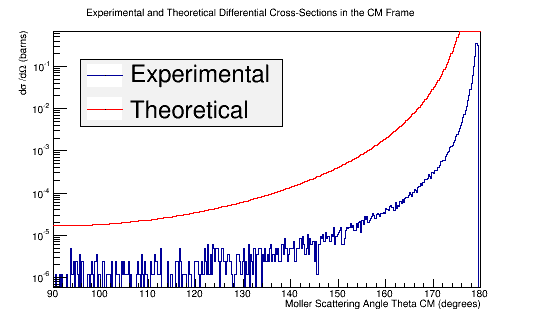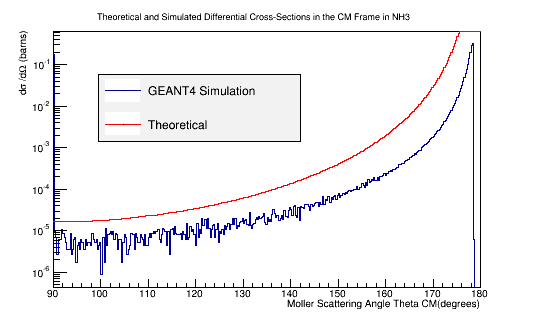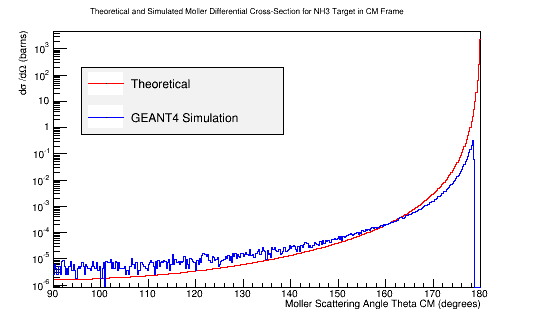Difference between revisions of "VanWasshenova Thesis"
Jump to navigation
Jump to search
| Line 242: | Line 242: | ||
=[[Mlr_Summ_TF]]= | =[[Mlr_Summ_TF]]= | ||
| + | |||
| + | |||
| + | =[[Results]]= | ||
[[DV_RunGroupC_Moller]] | [[DV_RunGroupC_Moller]] | ||
| − | |||
=[[Monte Carlo Binary Collision Approximation]]= | =[[Monte Carlo Binary Collision Approximation]]= | ||
Latest revision as of 02:30, 30 May 2019
Introduction
Moller Scattering
Moller Scattering Definition
Relativistic Frames of Reference
Relativistic Units
4-vectors
4-momenta
Frame of Reference Transformation
4-gradient
Mandelstam Representation
s-Channel
t-Channel
u-Channel
Limits based on Mandelstam Variables
Limit of Energy in Lab Frame
Limit of Scattering Angle Theta in Lab Frame
Initial 4-momentum Components
Initial Lab Frame 4-momentum components
Initial CM Frame 4-momentum components
Special Case of Equal Mass Particles
Total Energy in CM Frame
Scattered and Moller Electron Energies in CM Frame
Final 4-momentum components
Final Lab Frame Moller Electron 4-momentum components in XZ Plane
Final Lab Frame Moller Electron 4-momentum components in XY Plane
Momentum Components in the XY Plane Based on Angle Phi
Final CM Frame Moller Electron 4-momentum components
Final CM Frame Scattered Electron 4-momentum components
Final Lab Frame Scattered Electron 4-momentum components
Summary of 4-momentum components
Verification of 4-momentum components
Feynman Calculus
Flux of Incoming Particles
Invariant Lorentz Phase Space
Relativistic Differential Cross-section
Scattering Amplitude
Differential Cross-Section
Moller Differential Cross-Section
Plotting the Differential Cross-section
GEANT4 Simulation of Moller Scattering of Target Material
LH2 Target
6e7 incident electrons on 1cm square LH2 target Simulation Setup
6e7 incident electrons on 5cm cylinder LH2 target Simulation Setup
6e7 incident electrons on 1mm cylinder LH2 target Simulation Setup
Converting the number of scattered electrons per scattering angle theta to a differential cross-section in barns.
Benchmark GEANT4's Moller scattering prediction with the theoretical cross section using LH2
Comparison of simulation vs. the theoretical Møller differential cross section using 11 GeV electrons impinging LH2
Effects Due to Target Length
NH2 Target
Replacing the LH2 target with an NH3 target
Benchmark GEANT4's Moller scattering prediction with the theoretical cross section using NH3
Comparison of simulation vs. the theoretical Møller differential cross section using 11 GeV electrons impinging NH3
LH2 Vs. NH3
Benchmark GEANT4's Moller scattering prediction for NH3 and LH2
Effects Due to Target Material
Target Density
Atomic Mass and Electron Number Effects
Differential Cross-Section Offset
Modeling the EG12 Drift Chamber
Drift Chamber
Determining wire-theta correspondence
GEMC Verification
CED Verification of DC Angle Theta and Wire Correspondance
DC Super Layer 1:Layer 1
DC Binning Based On Wire Numbers
Detector_Geometry Simulation
Conic Sections
Circular Cross Sections
Elliptical Cross Sections
Determing Elliptical Components
Determing Elliptical Equations
Test for Theta at 20 degrees and Phi at 0
In the Detector Plane
Test in Plane for Theta at 20 degrees and Phi at 0
Test in Plane for Theta at 20 degrees and Phi at 1 degree
Function for change in x', Lab frame
Wire Number Function
Mathematica Simulation
In the Detector Frame
In the wire frame
Points of Intersection
The Wires
Right Hand Wall
Left Hand Wall
The Ellipse
Plotting Different Frames
Parameterizing the Ellipse Equation
Change in Wire Bin Number
One Hit per Wire Bin
One Hit Per Wire Bin at phi=0
Wire Bin Number as a function of Theta and Phi for Right Side
Wire Bin Number as a function of Theta and Phi for Left Side
Preparing Drift Chamber Efficiency Tests
Uniform distribution in Energy and Theta LUND files
1000 Events per degree in the range 5 to 40 degrees for Lab Frame
Isotropic Spread in CM for 5 to 40 degrees in Lab Frame at Phi=0
Isotropic Spread in Lab Frame for 5 to 40 degrees in Theta and for Phi between -30 and 30 Degrees
Reading_LUND_files
Run GEMC Isotropic Theta and Phi for Sector 1 DC
Analysis of evio files
Little Runs
Bin Test
Field Test
Bin Shapes
Limit Adjustment on Walls
HITs in DC
Hits with Changing Torus Field and 0T Solenoid
Too Large Events
Hits with -5T Torus and Changing Solenoid Field
Weight
Detector Occupancy
Defining Occupancy
Unweighted Occupancy
Weighted Occupancy
Rates
Gamma Event Vertex
Whitney Rates
GEANT Moller Simulations
Comparison of GEANT Simulation to Whitney Data
Occupancy for Sector 1
Rates for Sector 1
Rates for Different Currents
Rates for Different Solenoid Strengths
Rates for all Sectors based on Initial Sector 1 incident Moller electrons
Changing Solenoid Field Rates in Sector 1
Pb Cylinder (AKA "Temp Shield")
Understanding GEMC Component Effects
rename "s/.stl/.junk/" *.stl


